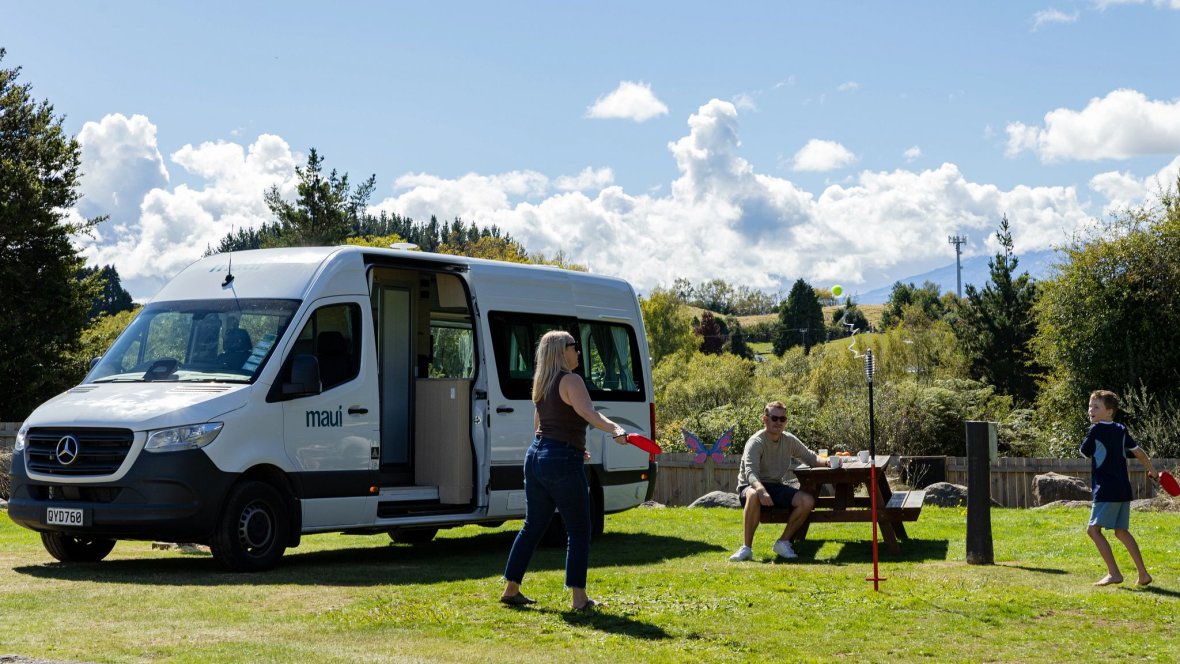Understanding the types of campsites in NZ
New Zealand is known for its wide range of campsites, catering to different travel styles and budgets. Here are the main options:
DOC campsites
Run by the Department of Conservation, there are more than 200 DOC campsites across New Zealand, often set in remote and scenic reserves and national parks.
DOC campsites are grouped into three categories based on the facilities available: Serviced, Standard and Basic:
-
Serviced campsites are the most comfortable option. Facilities include flush toilets, tap water (sometimes untreated), kitchen benches, hot showers and rubbish collection. Some sites even have extras like laundry, picnic tables, cookers and fireplaces.
-
Standard campsites offer a more traditional camping feel. They have toilets and water – from a tap, stream or lake – and may also feature barbecue areas, cold showers, picnic tables, rubbish bins and a cooking shelter.
-
Basic campsites are for those who want a simple, remote experience. Expect basic toilets and an untreated water source like a stream or tank. It’s best to boil or treat the water before drinking.
Private campgrounds
Private campgrounds in New Zealand are a good choice if you’re after a few more creature comforts. These spots usually come with well-kept facilities like hot showers, kitchen areas with cooktops or barbecues, and sometimes even a laundry room. Most private campgrounds offer a choice of unpowered or powered sites. They’re a great place to meet other travellers, swap tips and stories, and enjoy a social camping atmosphere.
Holiday parks
New Zealand holiday parks, including the popular TOP 10 Holiday Parks, are a step up in comfort and convenience. These parks offer a mix of powered and unpowered sites, so you can choose what works best for your trip.
You’ll find communal kitchens where you can cook up a proper meal, hot showers to freshen up, laundry rooms for a quick wash, and shared BBQ areas perfect for a relaxed evening.
Many also have play areas for kids, swimming pools and TV lounges if you’re after a bit of downtime. Powered sites include a mains power point so you can charge your gear and run appliances, while unpowered sites are usually cheaper and tucked away in quieter corners of the park. The choice is yours – it’s all about how much comfort you’d like on your trip.
What is a powered campsite?
Powered campsites are designed for campers who want to plug in and enjoy a few extra comforts. These sites come with electrical hook-ups, giving you access to power for lighting, cooking and charging your devices. Some sites also have water connections, making it easy to fill up your fresh water tank.
Powered campsites are ideal if you’re travelling in a motorhome or campervan that needs a power source overnight. They’re also handy if you want to keep your gadgets charged, use kitchen appliances or simply have a few more home comforts on the road.
What is an unpowered campsite?
Unpowered campsites offer a more rustic, back-to-basics camping experience. These sites don’t have power connections, which means you won’t find electrical hook-ups or lighting. They’re often cheaper than powered sites and can be in more scenic and peaceful spots.
These campsites are perfect if you’re travelling in a self-contained campervan or if you’re happy to rely on your van’s battery and solar set-up. They’re also a good fit for budget travellers who are looking to stretch their dollars a bit further.
Camping without power puts you closer to nature. There’s something about settling in under the stars and waking up to birdsong – it’s a quieter and more relaxed way to spend the night. DOC campsites are a great example of unpowered options in New Zealand.
Responsible freedom camping
Freedom camping is a popular option in New Zealand. This means camping in designated areas outside of holiday parks and campgrounds. These sites are usually unpowered and basic, with minimal facilities – perfect if you’re self-contained and don’t mind roughing it a bit.
However, it’s important to follow local rules and only stay in places where overnight camping is allowed. Many towns and councils have specific freedom camping zones – always check signage and online resources before setting up for the night.
In New Zealand, motorhomes and campervans need to be certified self-contained if you’re freedom camping (which all maui motorhomes are). This means you’ve got a toilet, waste storage and enough fresh water onboard. Sticking to these rules keeps you – and the places you camp – safe and protected.
Remember to follow the Leave No Trace principles and remove all waste (including grey water, toilet waste, and rubbish) and dispose of this correctly.
Pros and cons: powered vs unpowered campsites
Both powered and unpowered campsites have their pluses and minuses, so it’s all about finding the right balance for your trip.
Powered sites are convenient if you like having a few more comforts. You’ll be able to run appliances, charge devices and have lighting at night. The main downside is that they usually cost more, and they can be busier, especially in peak season.
Unpowered sites are cheaper and tend to be quieter, which can make for a more relaxed stay. They’re a bit more sustainable, too, as you’re not drawing from the grid. The flip side is you’ll need to be more self-sufficient – charging can be limited, and you won’t have the same level of comfort.

Matching your vehicle to the right site
Choosing between powered and unpowered sites often comes down to how your campervan is set up. Motorhomes and larger campervans usually do best at powered sites. With electrical hook-ups, you can keep things like fridges, lights and heaters running smoothly. We recommend staying at a powered campsite every second night or so, to keep the motorhome’s house battery topped up.
Self-contained vans, on the other hand, can get by without power for a night or two if you’re careful about how you use your battery. It’s a good idea to plan ahead and make sure you’re properly charged up and prepared first.
READ MORE: How to choose the right motorhome
Where to find the best campsites in New Zealand
When it comes to finding great campsites across Aotearoa, the TOP 10 Holiday Parks network is a reliable choice. They offer powered and unpowered sites along with facilities like communal kitchens, showers and laundry. You’ll also find excellent private campgrounds and smaller holiday parks dotted around the country.
Popular regions like Queenstown, Rotorua and the Bay of Islands have plenty of options to choose from, whether you’re after a powered site with all the mod cons or a quiet, unpowered spot to unwind.
To help you plan your travels, check out our handy campsite guides:
To plan your stops easily, download the thl Roadtrip app. This handy app not only helps you find nearby campsites, but it also provides real-time updates on road conditions and can help you find fuel stops, amenities, and more.
Tips for first-time campers
If you’re new to campervan travel in New Zealand, a few simple tips can help make your camping experience as smooth and enjoyable as possible.
-
Choose campsites based on the season and your travel style – popular spots book up quickly in summer.
-
If you’re going for unpowered sites, make sure your campervan battery is fully charged and consider a motorhome with solar panels for longer stays.
-
Pack a headlamp or torch for moving around after dark, especially if you’re in an unpowered spot.
-
Use the thl Roadtrip app to research campsites and find up-to-date information about amenities.
-
Brush up on local camping rules and always follow the ‘leave no trace’ approach.
-
Mix it up – try a few powered sites for comfort and balance it with some unpowered or DOC sites for that wilder feel.
-
Finally, take your time settling in – there’s no rush when you’re camping, and the best part is often just kicking back and enjoying the simple pleasures.
Making the most of your camping experience
As you can see, both powered and unpowered sites have something to offer. Powered sites are great if you want to plug in, charge up and enjoy a few home comforts on the road. Unpowered sites can be quieter, cheaper and often come with a better view – they’re perfect if you’re keen to unplug and keep things simple.
At the end of the day, it’s all about finding what works for you. Maybe you’ll mix it up – a few powered stays for convenience, then some off-the-grid spots to really soak up the scenery.
Ready to hit the road? Book your maui campervan and explore New Zealand your way.
FAQs
What is an unpowered site?
An unpowered site is a campsite without an electrical hook-up. You won’t be able to plug in your appliances or charge devices, but you’ll usually pay less for the spot and enjoy a quieter, more natural camping experience.
What is the difference between powered and unpowered camping sites?
Powered sites give you access to electricity, which is handy if you’re travelling in a motorhome or have gear that needs charging. Unpowered sites don’t have electricity, so you’ll rely on your campervan’s battery and be a bit more self-sufficient.
What is a sealed powered site?
A sealed powered site is a powered camping spot with a hard surface like concrete or gravel. It’s a solid, flat place to park your campervan, which can make things easier if the weather turns wet.
Is free camping legal in NZ?
Free camping – or freedom camping – is allowed in New Zealand, but only in designated areas. Always check local signs and regulations before setting up for the night. Your campervan must be self-contained to use these sites legally.



